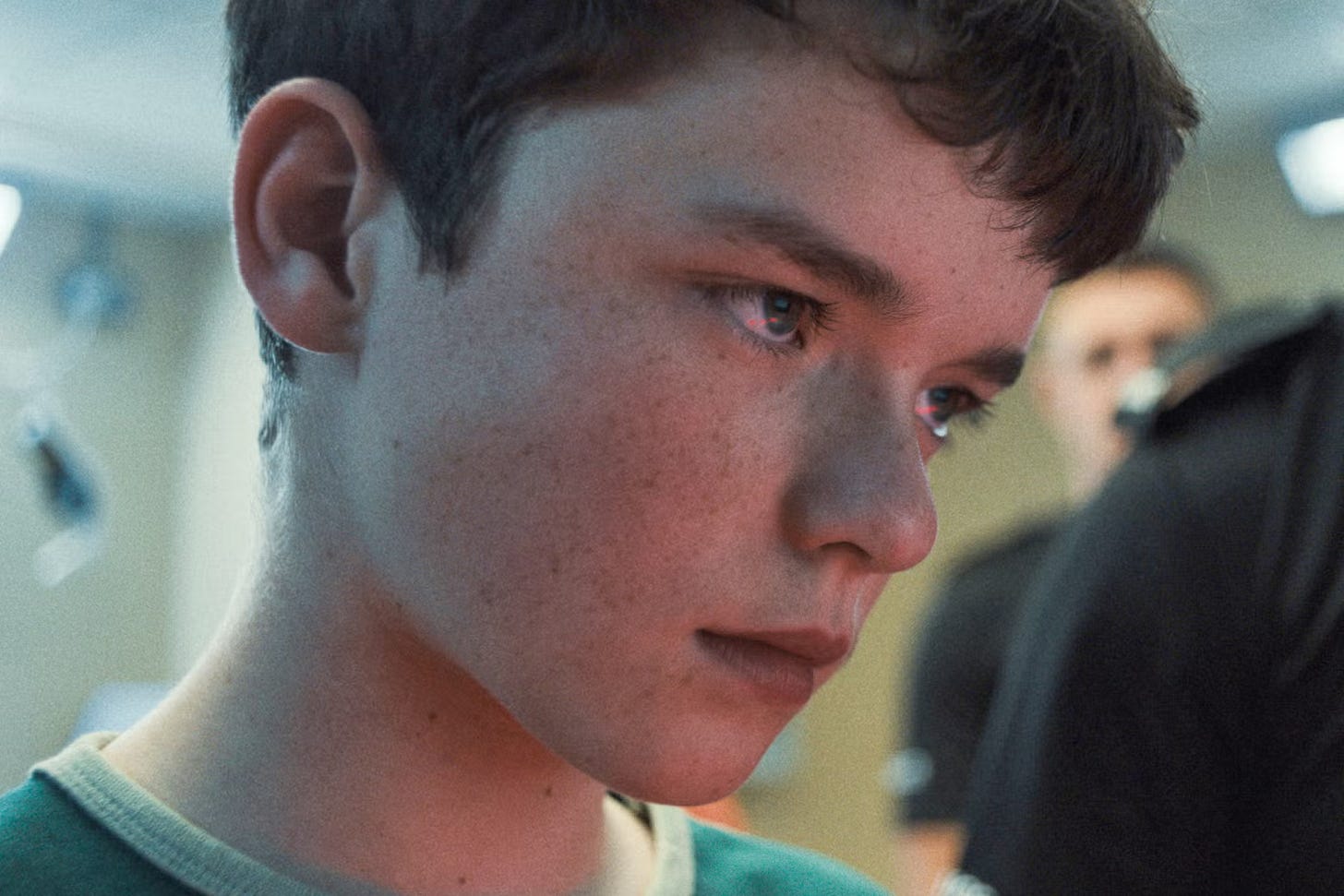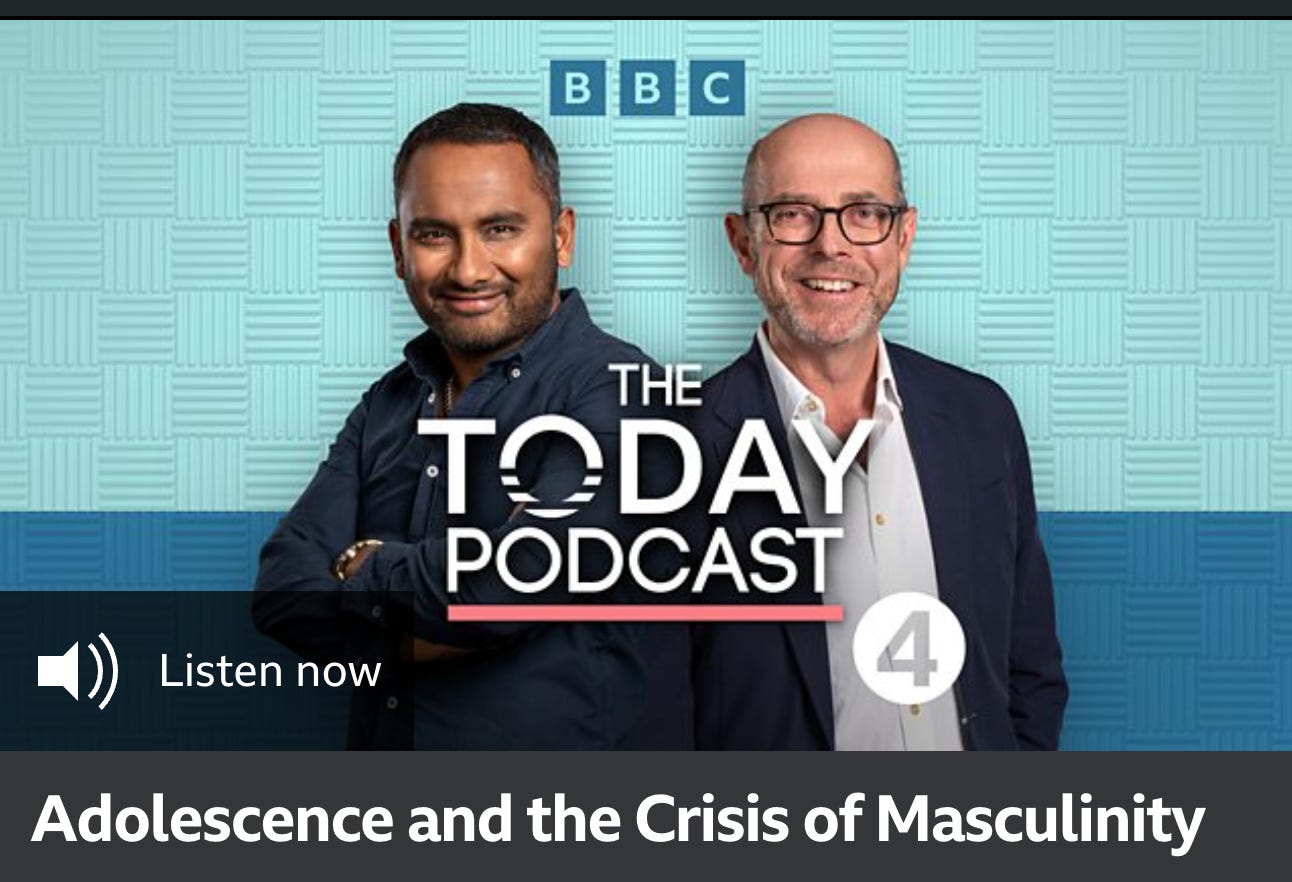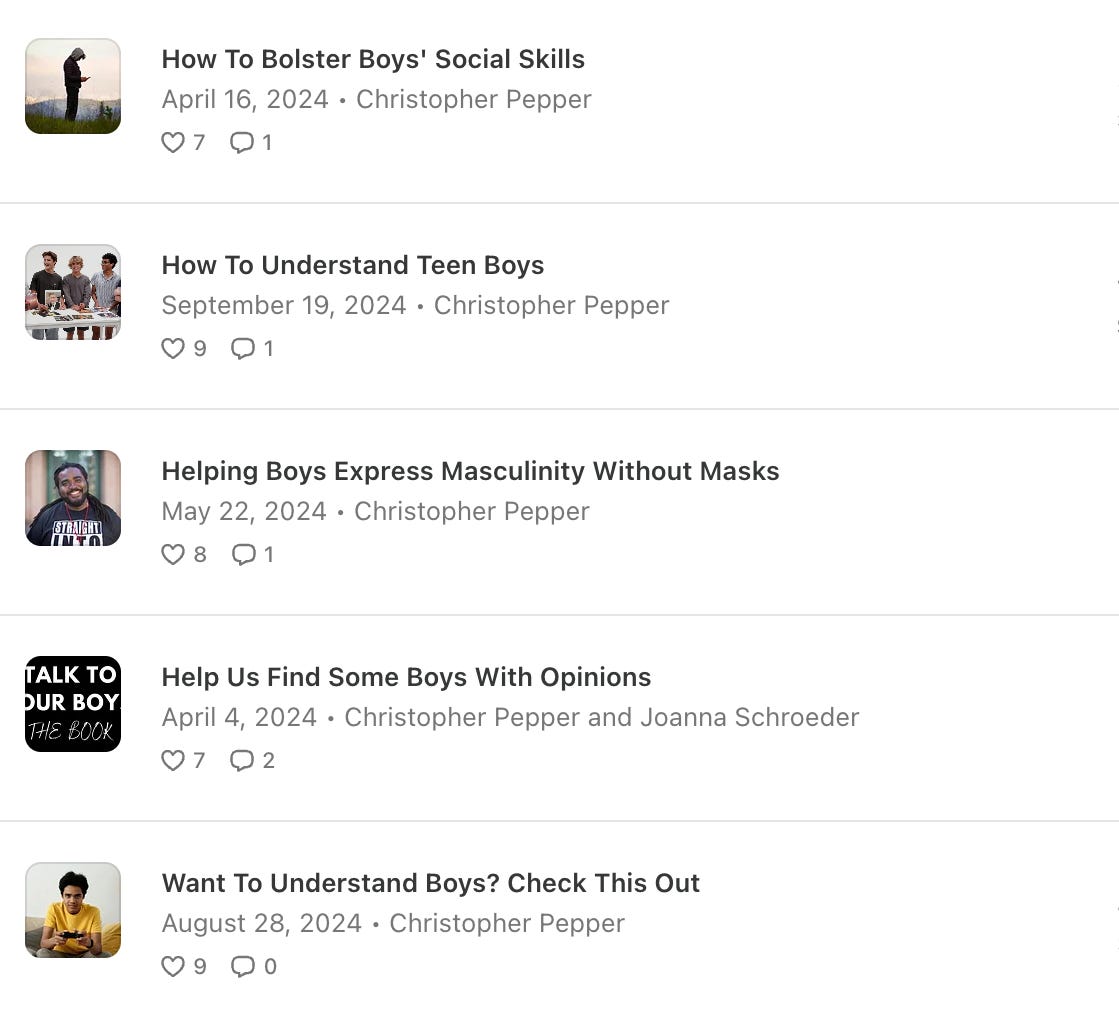How To Talk To Teens About "Adolescence"
The Netflix show is an artistic triumph and an enormous hit. It's stirred up lots of discussions about violence, teenage boys, and online misogyny.
An Astonishing Reaction To An Astonishing Show
For the past two weeks, my news feed has been full of stories about the four-part Netflix show “Adolescence.”
In addion to this piece by my “Talk To Your Boys” co-author Joanna Schroeder, Watching 'Adolescence' After 10+ Years Writing About Boys, here’s a sampling of the headlines that caught my eye:
‘Adolescence’ Becomes Netflix’s Most-Watched Limited Series in First 2 Weeks With 66.3 Million Views (The Wrap)
Why We All Need to Watch "Adolescence" (Gender (In)equality by Kate Mangino)
‘Adolescence’ Has People Talking. Its Writer Wants Lawmakers to Act. (New York Times)
I’ve Spent Time In Incel Forums - ‘Adolescence’ Is The Scary Reality Of Internet Misogyny (Harper’s Bazaar)
Netflix's "Adolescence" is A Good Depiction of How Masculinity in Crisis Doesn't Collapse but Consolidates (Unmanned by Soraya Chemaly)
“Adolescence”: The Fight For Boys’ Souls (Boys Of the Future by Francesca Cavallo)
It's Not Them; It's Us: Thoughts on the Show Adolescence (Meditations In An Emergency by Rebecca Solnit)
Netflix’s Adolescence Forces Us to Talk About Hard Things - Here's Why! (This Is So Awkward Podcast)
The show, which is about a 13-year-old boy who is charged with the murder of a female classmate, has generated a huge amount of interest in what’s going on with teen boys today.
Jonathon Reed, Laura Stocker, and I tried to address some of those concerns recently in Debunking Masculinity Norms in Schools, a discussion hosted by Next Gen Men as part of its new “Voice Male Talks” series. You can watch a recording of the event here, and find more resources in the accompanying digital handout.
“Here’s What Happened When I Watched ‘Adolescence’ With My 15-Year-Old Son”
On Instagram, Melissa Pintor Carnagey from Sex Positive Families shared her experience watching the show with her own teenage son:
We Were In Awe.
This four-part series, each episode shot in one take, drew us into the layered family and community dynamics that unfolded after a 13-year-old boy named Jamie murdered his classmate, Katie. This show didn't rely on sensationalized or graphic scenes to tell the story. Just raw emotions, honest and often hard conversations within human moments. We witnessed each one of them, together.We Learned...
what it can be like to be a young teen, boy, girl, a helping professional, teacher, parent, and community in this age of social media. We witnessed moments that influence a person's inner voice, body image, self-esteem, sense of belonging, triggers, actions toward themself and others. We learned the complexities of being human in today's highly digital world.We talked.
A lot. Pausing the video frequently to make space for our reactions and processing. In the pauses we talked about family, social media, bullying, misogyny, the legal system, toxic masculinity, emojis, feelings, parenting, inter-generational trauma, fear, loneliness, beauty standards, race, school systems, white privilege, anger, and love. We had important, brave conversations.We felt.
Episodes 3 and 4 had us meeting eyes with each other countless times as we watched the interactions unfold. It was a lot, but it wasn't too much. It was real and felt. By the final scene, we were both with watery eyes. The empathy and compassion we experienced was important. We felt many emotions, many times, together.
We connected.
We enjoy watching shows together, and what made this unique is it felt like we were watching the behind the scenes of people's real lives, moments we don't typically get to witness. My son's first words as the credits rolled were, "That was powerful." I agree, and I feel grateful for the connected experience we had watching this show together. We hope more families take time out to watch and connect too.
A Guide To Navigating These Conversations
Heather Barnard, the founder of Tech Healthy Families, says she had so many adults reach out about the movie, wondering how it relates to their children's online lives and how to talk about the movie with tweens/teens, that she decided to build a toolkit for these discussion. It includes:
A quick guide to the movie
A poster explaining emojis parents should really know
A checklist for pre/during/post viewing of the movie
A conversation guide with prompts, reasons why the questions are important, and follow up
How Coaches And Dads Can Use This Film
Kip Ioane from Teams of Men works with men who coach sports, and after watching “Adolescence’ with his 17-year-old son, he was inspired to create a viewing guide for coaches, mentors, and parents to use with young men. It includes:
Episode-by-episode breakdowns
Real-time reflection prompts
“Coach Sidebars” to process what’s happening off the court, too
Teen Health Today readers can request a free copy of the guide through this contact form.
Big Conversations About This Show
There are a lot of articles, videos, and podcasts focusing on “Adolescence.’ Here are a couple that I thought were especially compelling.
Context from Richard Reeves And Catherine Carr
In this episode of “The Today Podcast” from the BBC, Richard V Reeves, author of Of Boys And Men, and Catherine Carr, who produced the acclaimed audio documentary About The Boys discuss ‘Adolescence’ and what they’ve learned about the world of boys today.
To Be A Boy: The ‘Adolescence’ Episode
To Be A Boy is a new podcast from Joeli Brearley and Elliott Rae, and they recorded a speial episode reflecting on ‘Adolescence’ and offering support and help to parents. Here’s what Elliott writes about it:
“Just as ‘Adolescence’ is, this podcast episode is raw and a tough listen at times. We reflect on the key themes around misogyny, violence against women and girls and the manosphere. We talk to a mother whose son’s life was badly affected by online content.
But we also offer hope.
By talking to a child psychologist and the NSPCC about what we as parents can do to keep our children safe.
We talk about how to have open conversations with our children, how to use online safety tools, how to learn about the manosphere and share resources to support the development of healthy parent/child relationships.”
Should We Show ‘Adolescence’ in Schools?
In its review, Common Sense Media says this show is ok for youth 15 and older, but as a teacher who tries to be trauma-informed, I would caution against showing it to a whole class of students as a lesson. I don’t like forcing anyone to watch depictions of violence or other tense scenes that could be scary or triggering.
Masculinity researcher Dr. Zac Seidler wrote about his concerns about the response to the film on LinkedIn:
There is a strong thread being discussed in the current discourse that we just need MORE education or MORE male role models and that this is a linear trajectory towards less misogyny, less mental health issues and less violence in young guys. This is short sighted and does not track with the research.
With the ascension of 'more' over 'what', we start to lose sight of the quality of what we're offering, where and how it shows up in young men's lives. We also start to overlook effectiveness (e.g. does this even work?). If we hear from many young guys that something doesn't resonate, it's not 'mollycoddling a fragile male ego' to flexibly pivot and co-create something that does with the same end goal of gender equity. If we want behaviour change in a certain group, you have to ensure you have buy-in from them to even start the conversation.
A current push to add 'Adolescence' to the school curricula for instance doesn't take into effect powers of backlash (or the 'boomerang' phenomenon). These decisions may well have positive outcomes for some young men who watch it in a learning environment, but it may also have unintended consequences for another group. Who is the teacher running the lesson? What is the history and life circumstance of the boys in the class?
As Jess Hill writes in her recent essay, "when men like this [high risk] are told they should be more empathetic towards women and girls, they are unlikely to be grateful for the correction; instead, they become defensive and resentful and hold on ever more firmly to their attitudes."
When I say we should seek to understand men's shame, their frustrations and their confusion, that does not mean ever condoning or excusing dangerous/bad/illegal/predatory behaviour. What it does mean is that mental health issues, trauma, addiction AND misogyny can co-exist (and in fact strengthen one another), and should and must both be addressed to make meaningful change.
What Comes Next?
I am excited and grateful that so many people want to know more about the world boys are growing up in now. These are issues Joanna Schroeder and I focus on a lot in our upcoming book Talk To Your Boys, and I’ve been fielding a lot of calls to speak to the public about boys and masculinity.
There are lots of things people dan do at home and in school to support boys and help them develop their identities in a healthy ways. For ideas, look overs some of the pieces I have published about supporting boys in this newsletter. Check them out here:
There’s a lot to think about. Good luck!
— Christopher









Thank you for providing so many resources for parents & others!